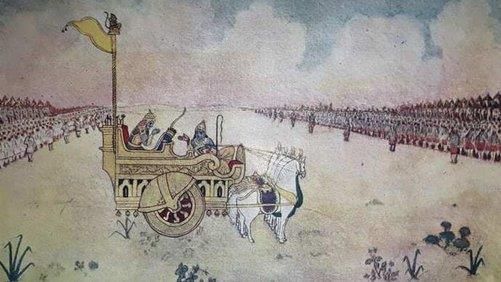|
Card: 1 / 40 |
The Mahabharata was composed over approximately ___ years, starting around ___ BCE. |
|
Card: 4 / 40 |
They composed poems celebrating the victories and achievements of Kshatriya warriors.  |
|
Card: 5 / 40 |
The project to create a critical edition of the Mahabharata was initiated in ___ under the leadership of ___ . |
|
Card: 7 / 40 |
True or False: The critical edition of the Mahabharata was completed in 20 years. |
|
Card: 9 / 40 |
Fill in the blank: The Mahabharata reflects the complex processes that shaped early and later social histories through dialogues between ___ traditions and ___ ideas. |
|
Card: 12 / 40 |
It revealed both common elements and significant regional variations in the text.  |
|
Card: 14 / 40 |
Patriliny refers to the practice of tracing descent from father to son, grandson, and so on, emphasizing male lineage in inheritance and social status. |
|
Card: 15 / 40 |
True or False: Exogamy was uncommon among high-status families in early Indian society. |
|
Card: 16 / 40 |
False. Exogamy, or marrying outside one's kin group, was common among high-status families to forge alliances. |
|
Card: 17 / 40 |
List the eight forms of marriage outlined in the Manusmriti and describe their significance. |
|
Card: 18 / 40 |
The eight forms of marriage include: 1) Brahma (gift of a daughter to a learned man), 2) Daiva (marriage by priestly arrangement), 3) Arsha (marriage with the giving of cattle), 4) Prajapatya (mutual consent), 5) Asura (purchase of the bride), 6) Gandharva (love marriage), 7) Rakshasa (capture), and 8) Paishacha (coercive). These forms reflect the evolving social norms and values regarding marriage.  |
|
Card: 19 / 40 |
Fill in the blank: Women were expected to adopt their husband's ___ upon marriage in the Brahmanical practice. |
|
Card: 21 / 40 |
How did the practice of metronymics reflect the status of mothers in early Indian society? |
|
Card: 22 / 40 |
Metronymics, or names derived from the mother, indicate the importance of mothers in naming conventions, suggesting that while succession was generally patrilineal, mothers held a significant role in social identity. |
|
Card: 23 / 40 |
What role did the Satavahana rulers' practice of polygyny play in kinship structures? |
|
Card: 24 / 40 |
Polygyny, the practice of having more than one wife, among Satavahana rulers indicated variations in family structures and highlighted the complexities of kinship and social alliances in early Indian society. |
|
Card: 25 / 40 |
What were the prescribed ideal occupations for the four varnas according to the Dharmasutras and Dharmashastras? |
|
Card: 26 / 40 |
The prescribed ideal occupations were: Brahmanas for studying and teaching the Vedas, performing sacrifices, and providing guidance; Kshatriyas for engaging in warfare, protecting people, and administering justice; Vaishyas for agriculture, pastoralism, and trade; and Shudras for servitude to the higher varnas.  |
|
Card: 27 / 40 |
Fill in the blank: The emergence of numerous ___ allowed for social mobility within specific professions beyond the four varnas. |
|
Card: 30 / 40 |
Guilds organized jatis based on occupation, reflecting a structured and collaborative approach to economic activities.  |
|
Card: 31 / 40 |
Describe the social status and responsibilities assigned to chandalas in Brahmanical texts. |
|
Card: 32 / 40 |
Chandalas were assigned degrading tasks and faced severe discrimination, with duties such as living outside villages, using discarded utensils, wearing clothes of the dead, and disposing of bodies.  |
|
Card: 33 / 40 |
What insights do historical texts like Fa Xian's accounts provide regarding untouchables? |
|
Card: 34 / 40 |
Fa Xian's accounts provide insights into the lives of untouchables and their social exclusion, highlighting the complexities of social hierarchies and the discrimination they faced. |
|
Card: 35 / 40 |
What limitations did women face in terms of property rights according to the Manusmriti? |
|
Card: 36 / 40 |
Women had limited property rights, with broader access to land, cattle, and money generally controlled by men, despite being able to retain gifts received at marriage. |
|
Card: 37 / 40 |
Fill in the blanks: The Vakataka queen Prabhavati Gupta exemplifies that wealthy women had some access to resources, but overall, land, cattle, and money were primarily controlled by ___. |
|
Card: 39 / 40 |
True or False: The Brahmanical texts portrayed all varnas as having equal access to wealth. |
|
Card: 40 / 40 |
False. Brahmanical texts assigned different occupations and privileges to each varna, indicating unequal access to wealth. |























